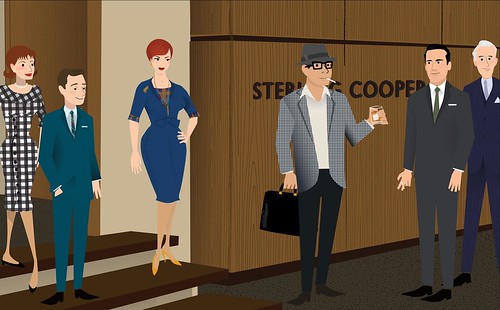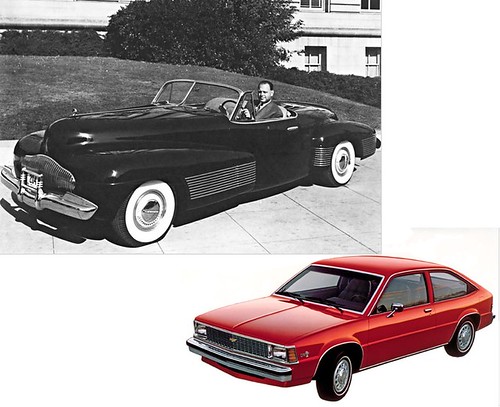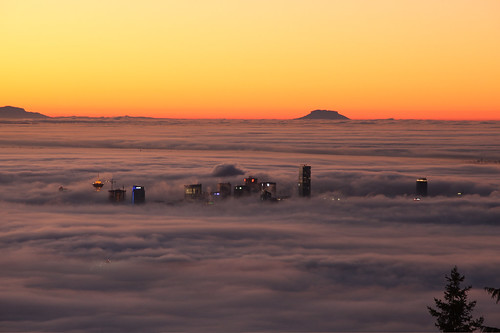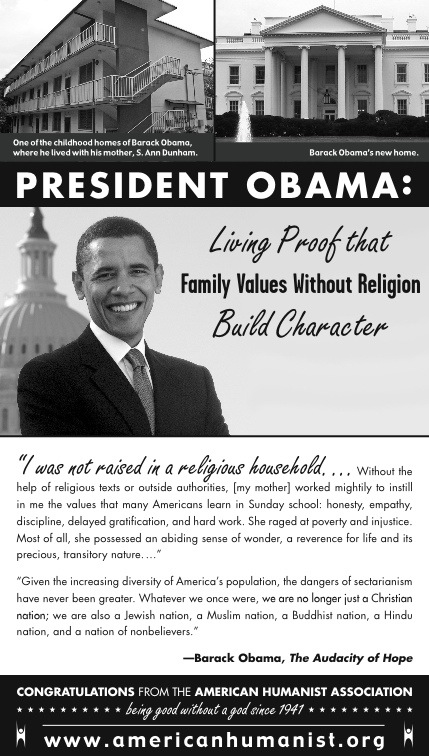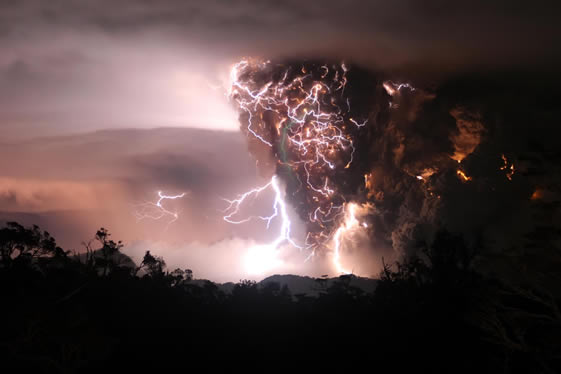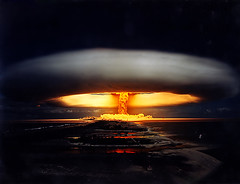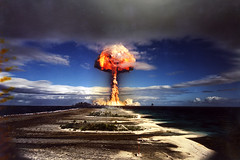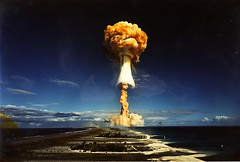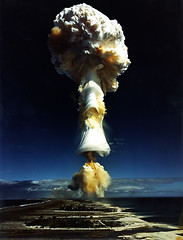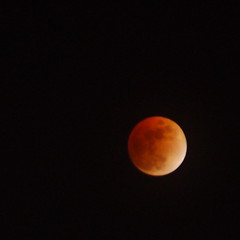Penmachine
28 April 2010
Following the camper
My former co-worker Chris got married to Kerry recently, and they're posting travel photos from their camper-van U.S. honeymoon, which have been great fun to follow. What I especially like is that their wedding presents included sponsorships of various parts of their journey, and they include thank-you printouts in many of the pictures, like this and this.
It's all just terribly charming. I've traveled a lot in the western U.S.A. over the years, especially Oregon and California, so their photos bring back many fond memories. Oddly, I've never visited Yosemite National Park. Maybe someday, if my health improves. Maybe.
Labels: americas, blog, friends, navarik, photography, travel, wedding
24 February 2010
I wish I'd discovered Craig Ferguson five years ago
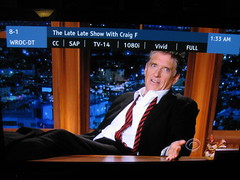 I've only occasionally stumbled on The Late Late Show With Craig Ferguson since he started hosting the program in 2005. It starts after 12:30 a.m., after all, and I'm not the night-owl musician I used to be. I always found him funny.
I've only occasionally stumbled on The Late Late Show With Craig Ferguson since he started hosting the program in 2005. It starts after 12:30 a.m., after all, and I'm not the night-owl musician I used to be. I always found him funny.
Since we got an HDTV and a PVR in January, we're not only easily able to record whatever shows we want, but we also have access to channels such as CBS Detroit that are on East Coast time—so Ferguson is on at a much more reasonable hour. I've been watching him pretty much every day.
That's because he's both extremely smart and entirely hilarious. I don't think I've ever laughed as much at any other late-night show, not Johnny Carson, not David Letterman, not Stephen Colbert or Jon Stewart. Interestingly, while The Late Late Show has a fairly traditional talk-show format, with a monologue and guests, Ferguson has no co-host/sidekick, and no band. And he's better for it.
He's also keen to disassemble how talk shows work, to change the format, to take humour out of awkward pauses and improvisations. (His 1000th episode last year was performed almost entirely by puppets.) It clicks completely with the kind of humour I like.
His memoir, American on Purpose, is also a great read as I recommended before. And you can follow him on Twitter. But he shines on late night, and you should watch him there. I wish I'd discovered his show five years ago.
Labels: americas, humour, television
14 January 2010
Quake risks
 Five years ago I wrote a long series of posts about the Indian Ocean earthquake and tsunami, compiling information from around the Web and using my training in marine biology and oceanography to help explain what happened. Nearly 230,000 people died in that event.
Five years ago I wrote a long series of posts about the Indian Ocean earthquake and tsunami, compiling information from around the Web and using my training in marine biology and oceanography to help explain what happened. Nearly 230,000 people died in that event.
Tuesday's magnitude-7 quake in Haiti looks to be a catastrophe of similar scale. I first learned of it through Twitter, which seems to be a key breaking-news technology now. Hearing that it was 7.0 on the Richter scale and was centred on land, only 25 kilometres from Port-au-Prince, I immediately thought, "Oh man, this is bad."
And it is. Some 50,000 are dead already, and more will die among the hundreds of thousands injured or missing. Haiti is, of course, one of the world's poorest countries, which makes things worse. Learning from aid efforts around the Indian Ocean in 2005 and from other disasters, the Canadian government is offering to match donations from Canadians for relief in Haiti.
This is a reminder that we live on a shifting, active planet, one with no opinions or cares about us creatures who cling like a film on its thin surface. We have learned, recently, to forecast weather, and to know where dangers from earthquakes, volcanoes, floods, storms, and other natural risks might lie. But we cannot predict them precisely, and some of the places people most like to live—flat river valleys, rich volcanic soils, fault-riddled landscapes, monsoon coastlines, tornado-prone plains, steep hillsides—are also dangerous.
Worse yet, the danger may not express itself over one or two or three human lifetimes. My city of Vancouver is in an earthquake zone, and also sits not far from at least a couple of substantial volcanoes. Yet it has been a city for less than 125 years. Quakes and eruptions happen in this region all the time—on a geological timescale. That still means that there has been no large earthquake or volcanic activity here since before Europeans arrived.
We would, I hope, do better than Port-au-Prince in a similar earthquake, but such chaos is not purely a problem of the developing world. The Earth, nature, and the Universe don't take any of our needs into account (no matter what foolishness people like Pat Robertson might say). We are at risk all over the world, and when the worst happens, we need to help each other.
Labels: americas, disaster, probability, science
15 October 2009
Sinking feeling
 Today, as part of Blog Action Day, I've agreed to write about the environment and climate change. I've done that here many times before, generally in a positive way, or at least a frustrated one. But not today.
Today, as part of Blog Action Day, I've agreed to write about the environment and climate change. I've done that here many times before, generally in a positive way, or at least a frustrated one. But not today.
Maybe I'm just in a pessimistic mood, but honestly, I'm starting to think we're screwed. There are honest moves afoot, especially in Europe, to change patterns of human energy consumption and reduce carbon emissions. But here in North America, where we use more energy per person than all but a few very small countries, we're doing essentially nothing.
I first became aware of increasing human effects on the Earth's climate around Earth Day in 1990, almost 20 years ago, which was a pretty high-profile event. For awhile after that, there were lots of recycled products in the grocery stores, and talk of converting away from oil, gas, and coal to heat our houses, generate our electricity, and power our vehicles.
And then things slid back roughly to where they were before. Paper towels and toilet paper went from recycled brown to bleached white again. As the economy boomed, people who never went off-road or hauled lumber bought huge Hummers and pickup trucks. Politicians, businesspeople, activists, and others expended a lot of words about the problem of climate change. Yet here in Canada, while we've improved the efficiency of what we do, our overall emissions keep going up, despite our promises.
In the United States and Canada, we're distracted by economic crises and healthcare reform and celebrity scandals and cable reality shows. The developing world is growing too fast not to increase their own emissions. Europe and other countries making efforts aren't enough. By the time sea levels start rising in earnest and the social and political disruptions start, we probably won't be able to keep climates from changing all around the world.
So in all likelihood, we'll wait too long, and we'll have to adapt as our environment alters wildly around us. That will be expensive, disruptive, and probably bloody in all sorts of ways.
I'm not saying we should give up and do nothing, but right now it seems that, collectively, we (and I'm fully including myself here) are very nearly doing nothing by default. Since I have cancer, I don't know if I'll be around to see what happens in a few decades. But my kids will. They will most probably, as the curse goes, live in interesting times.
Labels: americas, blog, canada, environment, linkbait, news, politics
27 July 2009
Booze, smokes, girls, advertising
Here's what I'd look like if I were on the TV show Mad Men, set at the turn of the smokin', drinkin', womanizin' 1960s of Manhattan advertising men:
Image made using the Mad Men Yourself tool (via Kottke). My wife and I are making our way through the Season 2 DVDs right now, and I feel like I'm getting second-hand smoke through the television.
Labels: americas, cartoon, history, television, web
03 June 2009
The rise and fall of General Motors
There's a lot of talk about why General Motors slid into bankruptcy protection this week, but I think you can summarize the situation with two of the company's old cars (photos from the 2009 New York Times GM Timeline):
Top left, the amazing and beautiful 1938 Buick Y-Job concept car prototype (not a beautiful name, but still...), driven by GM design head Harvey J. Earl. That car appeared as the world's first concept vehicle, as GM was ascending to its all-time high U.S. market share, which reached 54% in 1954. It heralded the beginning of artistic design in automobiles, which through the 1920s had looked purely functional and utilitarian.
Bottom right, the 1980 Chevrolet Citation, a front-wheel-drive response to smaller Japanese cars from Toyota, Honda, and Datsun. The Citation was a big red hunk of meh, which drove poorly and lost sales in each of its five years on the market. The 1980s saw GM and other American car makers creating poor imitations of more successful foreign design ideas. GM was by then descending into its current state.
Labels: americas, design, money, transportation
30 May 2009
Luck and randomness
Randomness works in strange ways, at least as far as our minds are concerned. The stars in the sky are distributed essentially randomly (from our viewpoint), yet we see patterns in them—that's because a random distribution is clumpy, not even.
Since our brains seek patterns, we tend to see patterns in random things, like clouds, stains, or the browned surfaces on pieces of toast.
Now check this out: New Jersey grandmother Patricia Demauro played craps at a casino, and rolled a pair of dice 154 times without ever rolling a seven, over the course of more than four hours. The odds? 1.56 trillion to one against. But it happened.
It wasn't impossible, just supremely improbable. Yup, that's random.
Labels: americas, games, probability, psychology
19 May 2009
Airliners are modern miracles of science and engineering
 We've just returned from a whirlwind trip. My daughters had an extra day off school, a professional day following the Victoria Day long weekend, so we made quick plans to stay in a hotel in the Seattle suburb of Lynnwood, Washington, a couple of hours' drive south of here. But to thread the needle of long weekend border traffic, we crossed our station wagon into the USA on Sunday and returned Tuesday.
We've just returned from a whirlwind trip. My daughters had an extra day off school, a professional day following the Victoria Day long weekend, so we made quick plans to stay in a hotel in the Seattle suburb of Lynnwood, Washington, a couple of hours' drive south of here. But to thread the needle of long weekend border traffic, we crossed our station wagon into the USA on Sunday and returned Tuesday.
I'm not quite sure how we fit all we did into the 54 hours we were away, but it included a number of family firsts. My older daughter is a big fan of shrimp, and has been enticed by endless ads for the Red Lobster chain of restaurants. We have none in Vancouver, so Lynnwood offered the closest location, and despite lingering memories of a 1995 food poisoning incident at a California location on our honeymoon, my wife and I agreed to go. We all enjoyed our meals there Sunday night, without later illness.
That was the least of the newness, though. My wife Air and I have traveled to Greater Seattle many times over the years, separately during our childhoods and together since we started dating, both with our kids and without, for fun and on business, as a destination and on the way elsewhere. Yet somehow neither of us had ever visited the wonderful Woodland Park Zoo, or Lynnwood's famous Olympus Spa, or Boeing's widebody jet factory in Everett. This trip we covered them all: the kids and I hit the zoo, Air visited the spa, and all four of us took the Boeing tour today on the way home.
The zoo impressed me, especially the habitats for the elephants, gorillas, and orangutans, but while it was a much shorter activity, the Boeing tour was something else. If you live in this part of the world (Vancouver, Seattle, Portland, and environs), and you're a geek who likes any sort of complicated technology, or air travel, or simply huge-ass stuff, you must go, especially considering there's nowhere else in the world you can easily see something similar. The Airbus factory in France requires pre-registration months in advance, with all sorts of forms filled out and approvals and so forth. We just drove up to Everett, paid a few bucks each, and half an hour later were on our way in.
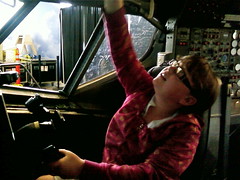 Unfortunately, you're prohibited from taking cameras, electronics, food, or even any sort of bag or purse beyond the Future of Flight exhibit hall where the tour begins, so I have no photos of the assembly plant itself. Trust me, though, it is an extraordinary place. A tour bus drove our group the short distance to the structure, which is the most voluminous building in the world. (Our guide told us all of Disneyland would fit inside, with room for parking. Since the plant is over 3,000 feet long, I figured out that the Burj Dubai tower, the world's tallest building, could also lay down comfortably on the factory's floor space.)
Unfortunately, you're prohibited from taking cameras, electronics, food, or even any sort of bag or purse beyond the Future of Flight exhibit hall where the tour begins, so I have no photos of the assembly plant itself. Trust me, though, it is an extraordinary place. A tour bus drove our group the short distance to the structure, which is the most voluminous building in the world. (Our guide told us all of Disneyland would fit inside, with room for parking. Since the plant is over 3,000 feet long, I figured out that the Burj Dubai tower, the world's tallest building, could also lay down comfortably on the factory's floor space.)
From two separate third-level vantage points inside, accessed by walking down immensely long underground tunnels, then taking freight elevators up into the factory's rafters, we saw more than a dozen of the world's largest aircraft in various stages of assembly. They included several units of the venerable and massive Boeing 747 (its still-revolutionary design is older than me); a couple of nearly complete 767s; a string of 777s in their slow-crawling, constantly-moving U-shaped assembly line; and finally a trio of 787s—a design so new that they are built mostly of composite materials instead of metal, and not even one has yet entered commercial service.
The end of the tour took us outside again on the bus, past the painting hangars and numerous planes waiting for pickup by airlines, as well as one of Boeing's three Dreamlifter cargo monsters, created by cutting off most of the upper half of an old 747 and installing a huge new fuselage top, purely to bring in assembled parts for the new 787s, to be fitted together inside the factory.
While that facility is one structure, which has been expanded over time, each type of plane built there demonstrates how aircraft construction, and industrial assembly lines in general, have changed in the past 40 years. 747s are still built at numerous discrete stations, as they were when the Everett plant first opened in the 1960s. As I mentioned, 777s come together in a single, steady-moving U-shaped line, apparently inspired by the envied Toyota Production System, each plane edging forward steadily at 1.6 inches per hour.
Finally, the new 787 comes together in a short, simple line across the width of the building. That's because (as with competitor Airbus's planes) sections of each aircraft arrive nearly complete from other factories around the world on the Dreamlifter cargo carriers, and are put together in Everett, rather than built from scratch.
I came away newly inspired by the modern miracle of science and engineering that is a jet airliner. These machines are what enable us to complain about waiting around in airports for a few hours, and about substandard in-flight food as we fly between continents—while forgetting that not many lifetimes ago, and for all of human history beforehand, similar voyages might take have taken us years instead of hours, facing danger and starvation and death, if they were possible at all.
Then, on the way home, we bought a bunch of squeeze cheese, also unavailable here in Canada.
Labels: airport, americas, animals, family, geekery, science, seattle, transportation, travel
18 May 2009
Boom
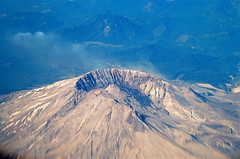 On the morning of May 18, 1980, exactly 29 years ago, I was camping with my Boy Scout troop at Furry Creek, north of Vancouver on the shore of Howe Sound. (The location is now part of a large golf course development, but at the time was essentially just forest near the highway.)
On the morning of May 18, 1980, exactly 29 years ago, I was camping with my Boy Scout troop at Furry Creek, north of Vancouver on the shore of Howe Sound. (The location is now part of a large golf course development, but at the time was essentially just forest near the highway.)
We awoke, terrified, to an enormous thundering crash. It was not, as we had thought, a train derailment on the railroad right near our campsite. It was the titanic sound of the eruption of Mount St. Helens—a sound which had arrived after traveling about 300 km northwest from the explosion. Back in Vancouver, my dad thought our water heater had exploded in the basement.
It was a good reminder that we live in a zone of earthquakes and volcanoes.
Labels: americas, anniversary, history, volcanoes
17 April 2009
Cannon Beach days
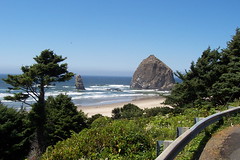 My wife, kids, and I have spent quite a bit of time in Cannon Beach, Oregon, where we took our summer vacations several years in a row. We like the place: it's in the United States, another country, yet it's part of the same sort of coastal ecosystem as we have here in British Columbia. So it's familiar, yet foreign, and one of my favourite places.
My wife, kids, and I have spent quite a bit of time in Cannon Beach, Oregon, where we took our summer vacations several years in a row. We like the place: it's in the United States, another country, yet it's part of the same sort of coastal ecosystem as we have here in British Columbia. So it's familiar, yet foreign, and one of my favourite places.
Today my parents, who are returning from a road trip to San Diego, have happened into staying a night in Cannon Beach too. They phoned me tonight as they had a light dinner and wine on the patio of their motel, watching the sunset. Today is also their 44th anniversary. They like the place too.
Incidentally, after they checked in, my mother realized that, decades ago, she had stayed at the same motel with her longtime friend Erlyne.
Labels: americas, anniversary, cannonbeach, family, holiday, travel
15 February 2009
How to make a pleasant airport
Salon's Patrick Smith, pilot and aviation writer, has a great list of 15 things all airports should have, created in consultation with his readers:
- A fast, efficient, low-cost public transportation link to downtown
- Complimentary wireless Internet
- Power ports
- Convenience stores ("What's with all the luggage stores? Who the hell buys luggage after they get to the airport?")
- Showers and a short-stay hotel
- Play area for children
- ATMs
- An information kiosk
- A place to send mail and buy postage
- A bookstore
- Ample gate-side seating: at least as many chairs as there are seats on the plane!
- A quiet area
- Art and greenery
- Double-wide escalators
- Windows with a view of the planes
Vancouver's airport is pretty good (the transit is coming this year, there's a good play area, and you can see the planes in several places), but in general we do a crappy job of these in North America.
If you're killing time at YVR, I strongly recommend a (slightly pricey) meal or drink in the lounge of the attached Fairmont Hotel. It's quiet, comfortable, the food is good, and you can both watch the aircraft and enjoy a nice view of our mountains. We try to go there anytime we're flying, or even dropping off or picking up family and friends.
Labels: airport, americas, transportation, vancouver
28 January 2009
Saddleback
The world's favourite sex columnist and podcaster, Dan Savage, has discovered another good definition of the word saddleback, with reference to Pastor Rick Warren's Saddleback Church.
The back story: Rick Warren has gajillions of followers across the U.S., and is the author of the bestseller The Purpose Driven Life. He gave the benediction prayer at President Obama's inauguration, much to the chagrin of gay activists and other people who supported Obama's social agenda—because Warren supported California's Prop 8 to abolish gay marriage, and follows the usual conservative evangelical line on most other social and sexual issues too. Even so, he is considered progressive by some people (or not conservative enough by some others) because he emphasizes improving the lives of poor people around the globe, as well as combating global climate change.
Warren's church is called the Saddleback Church, so Dan Savage asked his readers and listeners for another good definition of the word. Hence saddlebacking.
Labels: americas, controversy, politics, religion, sex
23 January 2009
Two Vancouver fog photos, almost completely identical
Was the now-famous Vancouver fog photo taken by Scott Miller from the Vancouver Sun, or Blair Kent? As I show in this short video, the answer could be... both:
The two images were made at almost the same time, in almost exactly the same location off the Cypress Bowl road above Vancouver. But they are two different photos—the clouds have moved, and the tree in the corner shows a very slightly different perspective.
So, to Scott and Blair both: great pictures. I can't say which is better.
Labels: americas, photography, sunshine, vancouver, video, weather
21 January 2009
Wow
Thanks to Buzz Bishop for posting this astonishing photo of our lovely city of Vancouver from Cypress Mountain, taken on the morning of Sunday, January 18 from above the fog that has enshrouded us for a couple of weeks now:
This picture was taken with a brand new Canon EOS 5D Mark II camera, taking full advantage of its remarkable resolution and detail in an amazing composition. Check out the large version. Wow. Who took the photo is an interesting question, with an interesting answer I talk about in my next blog post.
The distant peaks are probably Stewart Mountain near Bellingham (left, about 925 m tall) and Mount Constitution on Orcas Island (right, about 730 m) in Georgia Strait, both across the border in the United States.
P.S. Here's a whole set of photos from another photographer.
Labels: americas, photography, sunshine, vancouver, weather
Obama, religion, and hard work ahead
I was driving to my oncologist appointment just after 9:00 a.m. yesterday when the Chief Justice of the U.S. Supreme Court inaugurated Barack Obama as President of the United States. I heard it on the radio, and I teared up a little. The oath of office itself was surprisingly short, and both Obama and the Justice stumbled a little with the words in their enthusiasm—it sounded refreshingly informal and real.
Almost a year ago, even before the economy started seriously tanking, I wrote about Obama, saying:
America and the rest of us need inspiration now. America's citizens need to say to us, and to themselves, "We have been on the wrong path, and we will choose a different and better way." To see and to listen to Barack Obama as president will demonstrate the beginning of that choice. If I'm right, I think he will win.
He did win. Yesterday he could celebrate and dance; today he has to start doing stuff. Web nerds like me see good signs in small things, like the new whitehouse.gov website, which is well designed, has a blog with RSS, uses valid code, and is search engine friendly. More importantly, he has already ordered a halt to military commission prosecutions at Guantánamo Bay. He meets his military advisors this afternoon to plan withdrawal of U.S. armed forces from Iraq.
His response to America's unusual religiosity (for a Western democracy) is also worth noting. President Obama was not involved with and did not endorse this ad in the Washington Post from the American Humanist Association (via PZ Myers), but I think it is a good sign:
The headline is "President Obama: Living proof that family values without religion build character," with supporting quotes from his bestseller The Audacity of Hope ("I was not raised in a religious household..."). Some people are gonna get steamed over this one, I'm sure, and use it to continue maligning the new President. But though he is a Christian now, Obama obviously knows the benefits of a secular state, and why his country's founders created America as such. He understands that the non-religious —like both his parents—can be good people and raise healthy children, like him, who make wise choices.
That he and his administration not only recognize, but celebrate the diversity of their country—and that, in his own carefully crafted words during the inaugural address, "our patchwork heritage is a strength, not a weakness"—is a strength in itself. He, like us, has seen in the past decade how parochial sectarianism can do vast harm around the world.
The man has enough good will from Americans, and many of the other few billion of us, that he need not work miracles immediately, but he also seems to know that he doesn't have too much time. He must work with the citizens who elected him to realign his country's domestic, foreign, energy, and environmental policies. He must translate his ability to inspire as a candidate into a mandate to inspire as the world's most powerful person. I think, and hope, that he is up to the task.
Labels: americas, government, politics, racism, religion
13 January 2009
Popeye is public domain
Slowly, some of our more familiar modern cultural icons are becoming public domain, and now Popeye is one of them.
Labels: americas, art, copyright, publicdomain
07 December 2008
The final 42 days
The Onion is always biting satire, but sometimes they turn out to be chilling prophets:
- SATIRE (December 2008) - President George W. Bush: "I'm Really Gonna Miss Systematically Destroying This Place." Ha ha.
- PROPHECY (January 2001) - Before Bush was even inaugurated: "Our Long National Nightmare Of Peace And Prosperity Is Finally Over." (Annotated version.) Yikes.
Ah, but what would comedy writers have done otherwise?
Labels: americas, humour, politics, web
26 November 2008
My favourite new word
The latest issue of National Geographic is, as usual, excellent, but my favourite bit of it is a new word. In Spanish, the word chatarra means "scrap," but it's also slang in Mexico for "junk food."
I think it could be a great word in English too: "Oh, those pork rinds are total chatarra."
Labels: americas, language, magazines
04 November 2008
President Obama
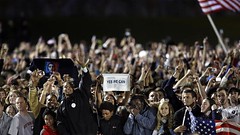 Back in February, I wrote:
Back in February, I wrote:
America and the rest of us need inspiration now. America's citizens need to say to us, and to themselves, "We have been on the wrong path, and we will choose a different and better way." To see and to listen to Barack Obama as president will demonstrate the beginning of that choice. If I'm right, I think he will win.
And so it is. I'm glad I wasn't wrong. Thank you for your choice, citizens of the United States of America.
Still waiting on news about Proposition 8. Fingers crossed.
Labels: americas, government, politics
28 October 2008
California's Proposition 8 is stupid
It has no direct legal bearing on us here in Canada, but still, the existence of California's Proposition 8, which asks the state's voters to ban same-sex marriage in the state's constitution next week, depresses me. Here in northern commie land, gays and lesbians have had the explicit legal right to get married since 2005, and you know what?
Canadian society has not collapsed. Heterosexual marriages haven't spontaneously combusted into invalidity—at least, not the ones that wouldn't have anyway. Gay people haven't been out on huge "recruiting" drives at local evangelical churches. Things are pretty much the same as before. Alas, a few of those married gay couples have even gotten divorced, as you'd expect.
So I like the point that this video (via Bad Astronomy) makes, by replacing "same-sex marriage" in a Californian pro–Proposition 8 ad with "interracial marriage":
Gay marriage doesn't seem to have destroyed People magazine either. So if you're a California voter who reads my blog and on whom I might have any influence—a pretty small number of people, I'd guess—then next week, in addition to voting for Obama (what? is that surprise from me?), please vote No on Proposition 8. It's unnecessary, and doesn't deserve the ink.
If I seem meddlesome here, hey, if any of my American readers had given me advice on how to vote in the Canadian election earlier this month, I would at least have considered your opinion. But none of you did!
Labels: americas, family, politics, sex
27 October 2008
The doom of the American car company
Via Brian Chin, the Wall Street Journal's "How Detroit Drove Into a Ditch" is a succinct history of why General Motors, Ford, and Chrysler are fumbling towards bankruptcy while the 16 U.S.-based vehicle factories run by foreign firms like Toyota, Nissan, Honda, Hyundai, Mercedes-Benz, and Volkswagen are profitable and prosperous:
...to thrive, instead of just survive, Detroit will have to use the brains of its workers instead of just their bodies, and the [United Auto Workers] will have to allow it. Two weeks ago some automation equipment broke down at the Honda factory in Marysville, Ohio, but employees rushed to the scene and devised a temporary solution. There were no negotiations with shop stewards, no parsing of job descriptions. Instead of losing an entire shift of production, Honda lost just 150 cars.
I don't think many people of my generation favour American brands when considering a new car. For me, GMs, Fords, and Chryslers are far from the top of the list: generally, when I sit in a new car built by one of those companies, something about it often feels cheap, which isn't the case with their Asian or European competitors' vehicles. Our Ford Focus has been a decent station wagon over the past seven years, but our Toyota Echo, which was much cheaper, has needed far fewer repairs.
Seeing one or more of the Detroit Three collapse would be sad, but personally I'd have no reason to miss them.
Labels: americas, money, transportation
19 October 2008
The shocking clarity of Colin Powell
In the upcoming American election, it's a pretty big deal to have former Secretary of State and general Colin Powell, a Republican, endorse Barack Obama, the Democratic nominee, for president:
Of course it's all over the news. But I'd like you to watch the video of his speech or, even better, read the transcript, then think about it a minute.
Notice how straightforward Powell's answers are. He doesn't dodge or prevaricate. He doesn't try to spin talking points or fire out sound bites, even about the Iraq War. When a reply needs detail, he provides it, and talks for some time, making an argument. When it needs simplicity, he offers it without extra padding. At the end, when a reporter asks if he's still a Republican, what is his answer—in its entirety? "Yes."
Such clarity in political speech is so rare that it is actually shocking. That people must be out of politics before they can really speak their minds this way is shameful. I'm sure many U.S. Democrats will applaud Powell for it, and many Republicans will excoriate him. But I'm glad he is self-secure and well respected enough that, to him, that obviously doesn't matter.
Labels: americas, language, politics, war
07 October 2008
London this morning
 When I was a kid, financial news was perhaps the most boring thing in the whole world, except maybe the TV farm report that frustratingly preceded early-morning cartoons. (That farm news seems to have disappeared here in Vancouver. Even the telephone weather line I used to check, pre-web, before bicycling to university each day, no longer reports hay drying conditions in the summer.)
When I was a kid, financial news was perhaps the most boring thing in the whole world, except maybe the TV farm report that frustratingly preceded early-morning cartoons. (That farm news seems to have disappeared here in Vancouver. Even the telephone weather line I used to check, pre-web, before bicycling to university each day, no longer reports hay drying conditions in the summer.)
I can't say that my opinion of money and business news has changed much in the intervening decades. It's usually a snore-fest of inscrutable numbers, impenetrable market analysis, and a parade of old guys in dark suits and ties. (Yeah, I hire an accountant to sort out my taxes after my perfunctory sorting of income and expenses each year.) Despite the impacts of global markets on everyone's ability to get a job, buy things, use credit, and so on, it always seemed so disconnected from my daily life that I just couldn't get interested.
Well, these past few weeks have certainly removed world financial news from the "boring" category, but I still can't pretend to understand what's going on very well. If you're like me, I strongly recommend This American Life's recent audio episode "Another Frightening Show About the Economy." Before you listen to that, however, I suggest you check out its predecessor from May 2008, "The Giant Pool of Money," which dissects the American sub-prime mortgage disaster that preceded the current credit crisis.
Both shows do an amazing job of explaining terminology such as "commercial paper," "credit default swaps," "leverage," "financial instruments," and other stuff I never bothered to learn about, and of putting together the chain of insanity that led to today's bizarro state of affairs, where supposedly laissez-faire conservative governments around the world are desperately spending hundreds of billions of dollars to nationalize banks and insurance companies. Even if you work in the finance industry, are a savvy investor, or otherwise have a handle on this stuff, check out the two shows. You'll likely learn something anyway.
UPDATE: Here's an even more direct explanation (via Kottke).
Labels: americas, europe, money, news, podcast, politics
25 September 2008
You too can be Sarah Palin's gay friend
You've gotta love Dan Savage, the world's most straightforward (but not straight), no-BS sex advice columnist and podcaster, who's based in Seattle. If you want to get a sense of the true variety of people's relationships and sex lives, read his column online or in your local paper, or listen to his weekly show. (Be warned: there's lots of swearing and frank sex talk, as you should expect.)
Recent news in the American election reveals that, while vice-presidential hopeful Sarah Palin claimed back in 2006 to have some gay friends, no one has been able to find any of them. So Dan, in his generous way, offers himself as a candidate for the position:
He has some good suggestion for the role he could play in Palin's family life. He's asking other gay people to post videos outlining their qualifications too. While you'll need to be gay to apply (so neither my wife nor I can join in), I don't think you have to be American. Though it might help.
Labels: americas, humour, politics, sex
10 May 2008
Volcano and thunderstorm
Via Kottke, here is a gallery of UPI photos of a thunderstorm meeting the volcanic plume from the Chaitén volcano in Chile this week. Check out picture #11:
Whoa, as Keanu would say. I never knew the Spanish term for thunderstorm before, but it's pretty nifty: tormenta eléctrica.
Labels: americas, disaster, environment, news, photography, science
30 April 2008
Hey neighbour
From Salon: "More and more, the strict new [U.S.-Canada] border rules appear to be a huge cultural and economic mistake. As the United States walls itself off against illegal immigration and terrorism, the relationship between Americans and Canadians will be a casualty."
Labels: americas, politics, security, travel
12 April 2008
Bomb days
A few days ago I wrote about the 50th anniversary of the Ripple Rock detonation, which sent me hunting around the Web for information. Inevitably, I came across lots of pictures of explosions of all sorts.
I think many people in a broad cohort around my age (38), who grew up during the Cold War, have a morbid fascination with photos of nuclear bomb tests. Some of them are chillingly, starkly, awfully beautiful, especially this set from the French Licorne ("Unicorn") test in the Pacific in 1970:
Reports say that the day of the Licorne detonation had "cloudy conditions but good visibility," but notice how the bomb's shockwave punches right through those clouds, sweeping them entirely away and leaving blue sky in the later pictures. Scary.
Of the hundreds of above-ground nuclear detonations by the U.S., the U.S.S.R., the U.K., France, and China between 1945 and 1980, no two seem to have looked the same. The photographs that freak me out the most are those where the surrounding landscape (and thus the scale) is clear. Or where soldiers walk towards a mushroom cloud in the Nevada desert.
China performed the last atmospheric test of a nuclear weapon almost 28 years ago—these sorts of photos are all, thankfully, now historical. But North Korea conducted what may have been a failed atomic explosion uderground as recently as 2006.
So those mushroom-cloud images don't worry me like they used to when I was a kid. But the worry isn't entirely gone either, is it?
Labels: age, americas, china, europe, history, korea, science, war
26 March 2008
The real stakes of a U.S. election
 I've just finished watching the full online version of the first part of "Bush's War" (via Kottke), an extraordinary PBS Frontline documentary about the tactical battles and infighting within the U.S. federal administration between September 11, 2001 and the initial invasion of Iraq on March 20, 2003.
I've just finished watching the full online version of the first part of "Bush's War" (via Kottke), an extraordinary PBS Frontline documentary about the tactical battles and infighting within the U.S. federal administration between September 11, 2001 and the initial invasion of Iraq on March 20, 2003.
It is a multi-hour program, extraordinarily depressing, though not surprising. The sinking feeling I had back in 2002—as I slowly lost the belief that there were good intentions somewhere, anywhere in the call to war—comes seeping back as I watch it.
I recommend you watch "Bush's War." (I plan to check out the second part tomorrow.) It is election season in the U.S. again, and it's worth some time for all of us, inside and outside America, to remember what the real stakes of voting in that country are.
Labels: americas, controversy, politics, terrorism, war
09 March 2008
What does a film about gays and religion mean to me?
At the video store yesterday my wife suggested we pick up For the Bible Tells Me So, a documentary about Christian families whose children come out as gay. Despite a slightly silly and jarring animated interlude, it's a good film.
It would be especially worthwhile for people in similar situations: those parents, relatives, and friends who have been brought up to think of gays and lesbians as "abominations" (in the words of an oft-cited Bible passage) but who want to maintain their religion and also accept a loved one's homosexuality. Or for those raised conservatively Christian who are gay themselves, and struggle with it.
But I'm neither gay nor religious. I'm an atheist, and my many friends who are gay, lesbian, or transgendered don't offend my sensibilities in any way. For me, the movie is more of an anthropological study, and a fascinating one because a religious life is so far from my own experience.
It makes sense to me that those who work to reconcile the Bible (or the Qu'ran, or other religious books) with many aspects of modern life often have tough work to do. Those books were written centuries or millennia ago, by people who knew nothing of gravitational theory, fossils, deep time, microbiology and germs, Big Bang cosmology, evolution, quantum mechanics and relativity, plate tectonics, organic and inorganic chemistry, absolute zero, the concept of a vacuum, and DNA—or even of the existence of the Americas, Australia, Antarctica, and the Pacific Ocean.
So if authorities at the time thought that homosexuality was unclean or improper or abominable, of course they wrote that into their religious texts. Accordingly, that same passage of the Bible also condemns wearing clothes of mixed fibres, cutting your hair a certain way, and eating shellfish and pork as equally wrong. Plus, other passages of those same books condone or accept slavery, physical abuse of women, pillaging and murder during wartime, and other things many of us now consider abominable.
And indeed, still other parts say you should sell all you have and give the proceeds to the poor, not squander your wealth wastefully, go forth and multiply, not be arrogant and boastful, forgive debts, and love your neighbour. Oh, and you shall not work on the Sabbath, shall honour your parents, shall not kill or commit adultery or bear false witness, etc.
You can consider those proclamations the words of men now long dead—words sometimes wise and transcendent, sometimes narrow-minded and obsolete. Or you can consider them the word of God. Then you might have to interpret what those words could mean in a time where we have stood on the Moon, created antibiotics, invented the Internet, changed the climate, developed sexual reassignment surgery, measured the age of the Universe, and reached a population exceeding six billion.
I find those interpretations interesting. But unlike the subjects of the film, including well-known gay Episcopal Bishop Gene Robinson, for me they are unnecessary. I have no personal need to reconcile modern ethics and morals with the Bible or the Qu'ran or the Vedas; with the teachings of Buddha or Lao Tzu or Confucius; or for that matter with the myths of the Spartans, Aztecs, Bantu, Haida, or Maori. Any or all of those things can inform my sense of right and wrong, but they don't define it.
All of us struggle to be good people. For the Bible Tells Me So can help some of us in that struggle. It's worth watching, whether its struggle is yours or not.
Labels: americas, film, movie, religion, science, sex
20 February 2008
Lunar eclipse photos from Vancouver
In Vancouver, the clouds cleared just long enough for some beautiful views of the lunar eclipse. I got some nice pictures (and so did my dad):
Mine were taken with a Nikon D50 camera on a tripod, and attached to a Sigma/Quantaray 70-210 mm zoom lens set at f/5.6, ISO 800, exposures generally between a half-second and two seconds. My dad took his with a Canon Digital Rebel XT attached to a Celestron C90 reflector telescope on a tripod, acting as a 1000 mm f/11 lens, with similar exposure times and ISO settings.
Labels: americas, astronomy, eclipse, moon, photography, science, vancouver
